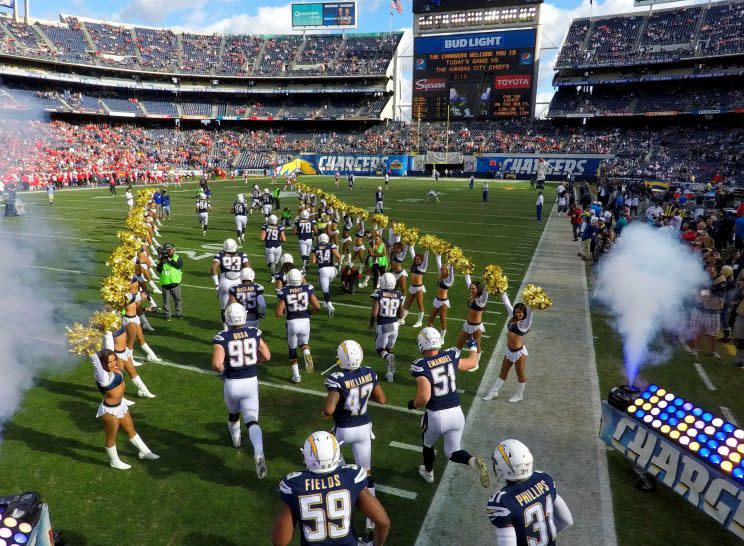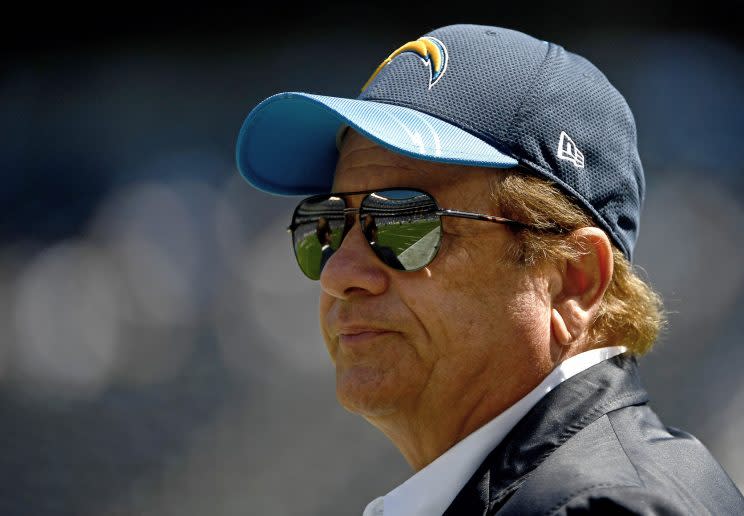Chargers' L.A. move reflects their history: mistake-prone and misguided
The San Diego Chargers never really could do anything right, so it’s not a surprise they got their own demise all wrong, too, courtesy of poor late-game strategy.
The Chargers always found creative ways to lose. They succumbed to decades of self-inflicted wounds, poor clock management and mind-numbing turnovers, usually just in time to snuff out a promising season. They repeatedly wasted the talents of the rare superstar who came along, unable to build around him. They lost more games than they won. They reached just one Super Bowl in 1995 and promptly got blown out.
They were lovable somehow, though, and certainly loved by a city that saw their charms through the frustrations. The cool uniforms. The lightning bolt. The “Super Chargers” fight song. The cannon. They were San Diego’s team, a constant as the city grew up around them, the shared community asset of which transients and new arrivals could grab ahold.
And that was enough. Or at least it was.
The San Diego Chargers are no more. Franchise owner Dean Spanos announced Thursday they are begrudgingly headed to Los Angeles. This is a classic Chargers maneuver. It’s a decision based more on being boxed into defeat than escaping for victory.
They are leaving a city they don’t really want to leave and one that doesn’t want them to go. They are moving to move, to a city they don’t really want to be in and one that doesn’t want them to come. Or, at best, doesn’t care.
There have been some ugly relocation dramas in NFL history, hurt feelings and double crosses. Robert Irsay had the Colts load up 15 moving trucks in the dark of night and slip out of Baltimore. Art Modell had his once-good name become mud in Cleveland. In St. Louis, cursing the Rams is part therapy, part entertainment. It’s never easy.
Yet at least at the other end of the line awaited a welcoming committee, a smiling mayor and throngs of excited fans. At least there was the promise of great things to come.
Not this time. This is uniquely Charger-esque.
“An exciting new era,” Spanos dubbed it in the announcement before acknowledging the challenge to “earn the respect and support of L.A. football fans.” See, when you relocate, it’s supposed to be easy. You don’t have to tell the new city it’s “exciting.” It’s already excited.
Spanos believes he has to go right now. The franchise has a window to join the Rams in Los Angeles that ends next week.
The Rams arrived last year when owner Stan Kroenke’s plan to privately fund a palatial development on land he acquired in Inglewood beat out the Chargers’ joint deal with the Raiders to get something built in Carson, Calif. It was an owner-vs.-owner contest of competence. Of course, Kroenke won. That was victory.
As a consolation prize, the Chargers can move into Kroenke’s stadium as a tenant for $1 per year. That’s a term of surrender. They had to decide now, though. If not, the option goes to the Raiders, who have far, far more fans in L.A., where they once played.
Oakland is likely to move to Las Vegas, but that deal is still being hashed out and could fall through at any moment. Spanos apparently didn’t want to risk having the Raiders switch. That would leave him in San Diego with no leverage against a local government that has shown little interest in building a stadium for a man worth more than $2 billion.
So here we go, nothing but a game of balance-sheet poker, with generations of fans caught in the margin.
Spanos will cry that he had no other option because San Diego wouldn’t agree to his demands over the past decade and a half. Moreover, voters rejected a ballot proposal in November on a hotel tax that could have funded a new stadium. That’s sort of true. The vote, however, was a hastily arranged proposal and came directly on the heels of Spanos’ effort last year to move to Carson with the Raiders.
That didn’t exactly excite the masses. What did he think was going to happen? Come back in 2018 with a different proposal, and who knows?
Besides, if Kroenke can spend his own money, why not Spanos? The local government was willing to help some. And the NFL offered its most assistance ever, $300 million to help on a $1.2 billion stadium. The league doesn’t want this either. This is certainly easy to say when it isn’t your hundreds of millions, but was this really impossible?
Instead, Spanos is going to pay a $550 million relocation fee to the league (Why not put that into the stadium?) and head off to what exactly?
Los Angeles went 22 years without an NFL team, and locals were pretty cool with that. If nothing else, they always got the best national games on television. With two franchises, that’s gone.
The Rams returned last year from St. Louis and there was a measure of excitement. It was a homecoming from the franchise’s early days and plenty of football fans gobbled up season tickets. Fans packed the mammoth L.A. Coliseum (temporary home) for both the preseason and regular-season opener.
Yet by season’s end, when the team was skidding to a 4-12 finish, struggled to score touchdowns and played with a general malaise, the fans stayed home. Good for them. Maybe any other city getting a new team would have a longer honeymoon, but this is L.A. It’s a winner’s town.
That’s about the Chargers’ only hope – that they can become winners (don’t laugh) and earn swing fans. It’s about all they have because nothing else is working in their favor.
The Rams have already identified the most passionate of local football fanatics, inked the best local media and sponsorship deals, and sold the most initial merchandise. It’s the Rams who will control the stadium, with an owner who is investing billions in an Inglewood community that needs it. It’s not a franchise that’s glomming on for a buck a year.
And it’s the Rams who will play two more seasons in the Coliseum, just south of downtown and close to all the Westside money, until the new place is built.
The Chargers will set up shop in Orange County (once the Rams’ old base). They are expected to play temporarily in a 30,000-seat soccer stadium up the road in Carson, which is still a Raiders stronghold. The small venue is about their only hope of making crowds look decent. They are hoping to retain some of the fans from Orange County who used to trek to San Diego for games, but that’s no guarantee, especially for displaced San Diego natives who see Spanos as a traitor to their old hometown.
That’s the move, though, rushed and ridiculous. The Chargers leave anger behind and find apathy ahead. They better do what they never have … win and win big. Spanos knows it, knows it desperately.
“We must get back to winning,” Spanos said.
They say there’s always room for another star in Hollywood. The Chargers will put that to the test.



